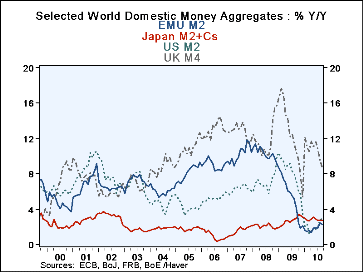 Global| Oct 27 2010
Global| Oct 27 2010EMU Money And Credit Growth Stumble
Summary
Global liquidity is going nowhere. In EMU the nominal growth rates for money supply growth have moved up ever so slightly over the past 12-months. The same cannot be said of real money growth. Inflation adjusted credit growth has not [...]
 Global liquidity is going nowhere. In EMU the nominal growth rates for money supply growth have moved up ever so
slightly over the past 12-months. The same cannot be said of real money growth. Inflation adjusted credit growth has not
picked up and it is essentially zero. Its nominal rate of growth is very weak. Euro-loan growth over three months declines once
inflation adjusted; on that basis it is nearly zero Yr/Yr as well.
Global liquidity is going nowhere. In EMU the nominal growth rates for money supply growth have moved up ever so
slightly over the past 12-months. The same cannot be said of real money growth. Inflation adjusted credit growth has not
picked up and it is essentially zero. Its nominal rate of growth is very weak. Euro-loan growth over three months declines once
inflation adjusted; on that basis it is nearly zero Yr/Yr as well.
In other countries money growth is still poor. In the US nominal money growth has moved up a bit, in the UK it is weakening and declining; in Japan it is steady at a slow pace. In real terms US money growth is flat, in the UK it is declining and in Japan, because of deflation, there is a bit more strength and a hint of acceleration.
In a world in which aggregate demand seems flat and consumer spending has been weak, there is little in the way of monetary stimulus. There also is little in this pattern to stimulate corporations to invest. On the other hand it cannot be argued that money growth is so weak it is creating deflation, except in the UK where you do not have it.
Interpreting monetary trends is made more difficult by the fiscal contraction in play across Europe and especially in the UK. Japan is planning some stimulus. The US has engaged stimulus and has unclear plans for the future beyond the probability of a further attempt at quantitative easing, which so far shows little impact on money growth rates. But the US past stimulus was so great that it may suffer some fiscal contraction from the expiration of past stimulus programs even if it does not mount any new efforts.
The upshot is that money growth does not seem to be introducing any new policy risks. The risks to the key global economies, the countries of the monetary center, seem to be from lingering financial sector and real economy issues.
| Look At Global And Euro Liquidity Trends | |||||||
|---|---|---|---|---|---|---|---|
| Saar-All | Euro Measures (E13): Money & Credit | G-10 Major Markets: Money | Memo | ||||
| €-Supply M2 | Credit:Resid | Loans | $US M2 | £UK M4 | ¥Jpn M2+Cds | OIL:WTI | |
| 3-MO | 3.8% | 2.5% | 0.5% | 5.0% | -1.8% | 2.7% | -2.5% |
| 6-MO | 3.7% | 3.5% | 3.1% | 4.5% | -0.8% | 3.4% | -14.7% |
| 12-MO | 2.3% | 1.9% | 1.9% | 3.0% | 8.7% | 2.8% | 7.7% |
| 2Yr | 3.2% | 1.6% | 0.8% | 5.0% | 9.6% | 2.9% | -14.9% |
| 3Yr | 5.4% | 4.7% | 3.4% | 5.6% | 10.0% | 2.6% | -1.8% |
| Real Balances: Deflated by Own CPI. Oil Deflated by US CPI | |||||||
| 3-MO | 1.5% | 0.2% | -1.8% | 2.2% | -3.9% | 5.2% | -5.0% |
| 6-MO | 2.4% | 2.2% | 1.8% | 3.9% | -2.7% | 5.5% | -15.2% |
| 12-MO | 0.5% | 0.1% | 0.2% | 1.8% | 5.5% | 3.7% | 6.4% |
| 2Yr | 2.4% | 0.8% | 0.1% | 5.2% | 7.4% | 4.5% | -14.8% |
| 3Yr | 3.6% | 3.0% | 1.7% | 3.9% | 6.7% | 3.1% | -3.3% |
| Japan's Latest CPI is estimated to complete this table | |||||||
Robert Brusca
AuthorMore in Author Profile »Robert A. Brusca is Chief Economist of Fact and Opinion Economics, a consulting firm he founded in Manhattan. He has been an economist on Wall Street for over 25 years. He has visited central banking and large institutional clients in over 30 countries in his career as an economist. Mr. Brusca was a Divisional Research Chief at the Federal Reserve Bank of NY (Chief of the International Financial markets Division), a Fed Watcher at Irving Trust and Chief Economist at Nikko Securities International. He is widely quoted and appears in various media. Mr. Brusca holds an MA and Ph.D. in economics from Michigan State University and a BA in Economics from the University of Michigan. His research pursues his strong interests in non aligned policy economics as well as international economics. FAO Economics’ research targets investors to assist them in making better investment decisions in stocks, bonds and in a variety of international assets. The company does not manage money and has no conflicts in giving economic advice.






